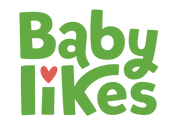Welcome to Weaning
Welcome to Weaning
Weaning your baby is a huge milestone—and at Baby Likes, we want to help make this journey easier, healthier, and more joyful for both you and your little one. Our halal and organic baby food is crafted to support each stage of weaning with nutritious, flavourful meals you can trust.
👶 What Is Weaning?
Weaning is the process of gradually introducing solid foods to your baby's diet alongside breast milk or infant formula. In the UK, the NHS recommends starting at around 6 months of age, when babies are developmentally ready for solids.
Signs of readiness include:
-
Sitting up with minimal support
-
Good head and neck control
-
Showing interest in food
-
Ability to swallow food rather than push it out
Stage 1 Weaning (Around 6 Months) – First Tastes
This is the time for gentle introductions. Your baby is learning how to eat, so keep portions small and textures smooth.
Key Characteristics:
-
Smooth purees only
-
Single ingredients to monitor for allergies
-
Introduced once a day alongside breast/formula feeding
Examples of First Foods:
-
Carrot Puree
-
Mashed banana
-
Steamed and blended sweet potato
-
Baby rice mixed with breast milk or formula
-
Pear or apple puree
Baby Likes Products: Our Stage 1 halal-certified pouches contain gently blended, organic single-ingredient meals such as:
-
Organic Apple Puree
-
Organic Butternut Squash
-
Organic Pear & Sweet Potato
These are perfect for introducing new tastes without overwhelming tiny tummies.
Stage 2 Weaning (7 to 9 Months) – Textures & Flavour Combinations
Once your baby has accepted a few single ingredients, it’s time to explore more variety and introduce combination meals and soft textures.
Key Characteristics:
-
Thicker purees and mashed textures
-
Two to three small meals per day
-
Mixed ingredients, gentle herbs and spices
Examples of Stage 2 Meals:
-
Mashed sweet potato with lentils
-
Baby Likes Rice & Chicken Baby Food Pouch
- Baby Likes Carrot and Lamb Stew Baby Food Pouch
Stage 3 Weaning (10 to 12 Months) – Family Foods & Finger Feeding
Your baby is now ready for more complex textures and small pieces of soft food they can pick up and chew.
Key Characteristics:
-
Chunkier purees and soft finger foods
-
Three meals a day with 1–2 healthy snacks
-
Increasing independence with self-feeding
Examples of Stage 3 Foods:
-
Soft-cooked pasta with veggie or meat sauce
-
Scrambled egg
-
Mashed chickpeas with tahini (watch for allergies)
-
Soft fruits like ripe mango, banana, or blueberries (halved)
-
Steamed broccoli florets
-
Baby Likes Organic Chicken with Wholegrain Rice & Veg
🌱 Why Choose Baby Likes for Weaning?
-
✔️ Halal Certified by Halal Quality Control (HQC)
-
✔️ Organic Certified by Ecocert & Organic Farmers & Growers (OF&G)
-
✔️ No GMO, artificial preservatives, or added sugar
-
✔️ Paediatrician-informed recipes with parent-approved taste
-
✔️ Convenient pouches for mess-free, on-the-go meals
We know how important it is for Muslim families to find baby food that aligns with both nutritional and spiritual values. Baby Likes is proud to provide halal and organic baby food you can feel confident about.
🌟 Tips for a Successful Weaning Journey
-
Start slow and follow your baby’s pace
-
Always supervise during meals
-
Reintroduce rejected foods after a few days
-
Make mealtimes a happy, stress-free experience
-
Offer water with meals once solids begin
